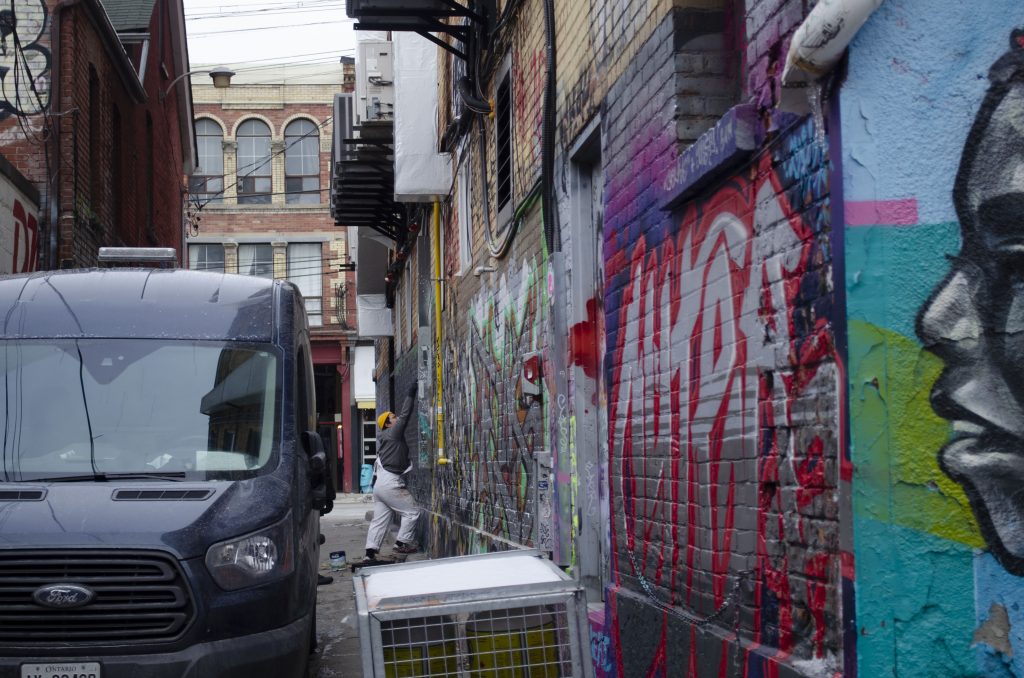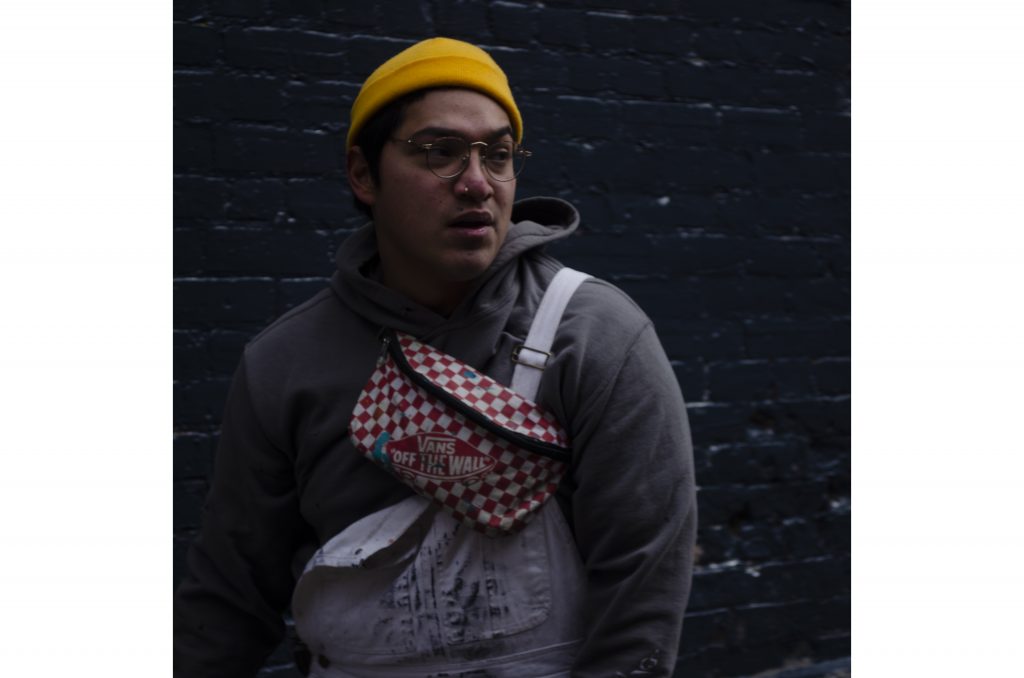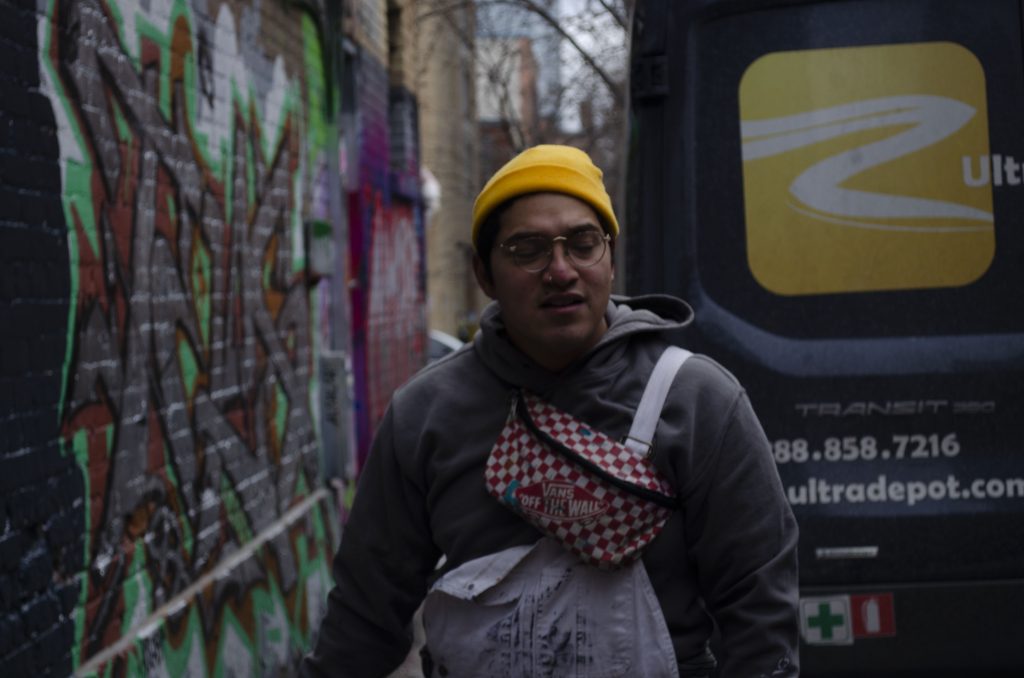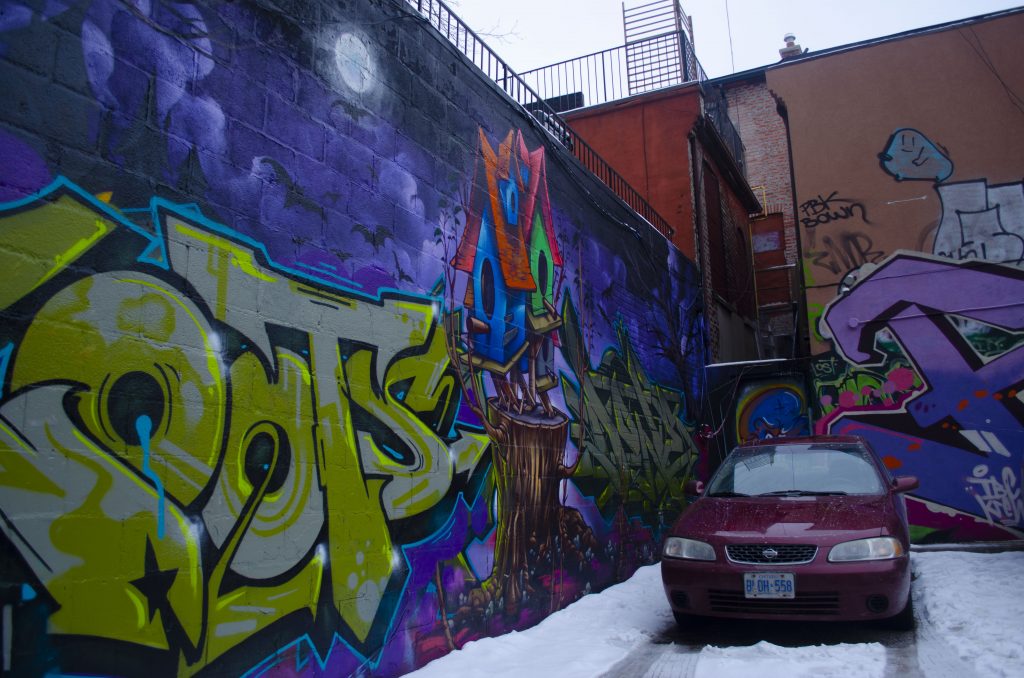Nigel tells me he isn’t a graffiti artist. He’s a street artist. A marked difference. His tool isn’t an aerosol spray can but rather a paintbrush.
As we meet in the busy downtown street near OCADU – formerly known as the Ontario College of Arts and Design – Nigel suggests we head north to check out a mural he painted nearby.
We enter a backyard through a wooden door on the side of the house. Someone’s painted over it.
“It’s been a while. It’s not surprising,” says Nigel.
It’s like the wild west out here, huh? I offer. He laughs knowingly.
Nigel begins to tell me that’s common downtown. There’s no more respect. Downtown is too visible. You’re a target. There’s not too many pieces of his around here anymore.
We concede that Toronto’s Graffiti Alley is probably our best bet. He says he can’t promise any of his pieces are still up but the visuals will look great.
Once we’re in the alley, Nigel cautions me not to get capture certain tags. Some of the tags are disrespectful. People painting over veterans.
“Some toy almost got a Poser bunny piece,” a nearby graffiti artist tells my companion.
A “toy” is pejorative term for novice or noob in the graffiti community, according to William Upski Wimsatt in his seminal journalistic work on graffiti culture in the 90’s, Bomb the Suburbs.
Weeks earlier, I spoke to another graffiti artist in a local shop downtown who refused to go on record. He told me that graffiti was competitive. You always have to be on your toes. A veteran artist himself in the Toronto scene, even he had people “tagging” over him.
“Graffiti is very competitive. You have to always keep practicing. If you take a year off, people will already forget you,” the veteran artist told me.
“There is a code but not everyone respects it,” he adds.

Nigel’s friend is taking a roller of paint to a wall to efface the gaudy tags. Streaks of dark bluish paint coalesce to create a new blank canvas. The artist is busy at work. Sporting overalls covered in paint, he turns to Nigel to discuss arcane and clandestine figures.


“So why do you want to cover graffiti?” the artist asks me.
I tell him graffiti is one of the few modes of art that hasn’t been sanitized.
In The Faith of Graffiti, journalist Norman Mailer explains how graffiti can be about reclaiming space. At the time of Mailer’s writing, Graffiti had exploded in New York City in the ’70s. Mailer explains that graffiti became a socio-political movement; for often poor kids, to reclaim the often repressive and bland architecture. In the book he writes:
“A communion took place over the city in this plant growth of names until every institutional wall, fixed or moving, every modern new school which looked like a brand new factory, every old slum warehouse, every standing billboard, every huckstering poster, and the halls of every high-rise low-rent housing project which looked like a prison (and all did) were covered by the foliage of graffiti.”

But graffiti hasn’t always been seen as positive. William Upski writes:
“Too often it becomes yet another incentive for people to ditch the city, crippling its tax base (which fund schools, hospitals..), and giving up on the ideal of America as a place where people from different backgrounds can come together for mutual benefit.”
Upski goes on to mention that graffiti as art can be elevated by looking at these three respects: content, location, and process.
“The process of graffiti should link its technical aspects to a greater hip-hop vision. Cleverness and risk are prized….The [graffiti] writer should constantly ask himself: Who exactly is my audience and how can I possibly move them?” Upski explains.

The general mood towards graffiti in Toronto has been ambivalent. Programs like StreetArt Toronto and the Laneway Project have tried to use graffiti to beautify the city. But then there are stories like that of the Kensington market shopkeeper beating up a local graffiti writer.
According to Global News, the city of Toronto received at least 382 complaints about graffiti in 2014. The focus being the west end and downtown core. By looking at the map below, you can see where most of the graffiti in the city is concentrated.
After shaking hands and snapping a few photos, Nigel shows me around some more. His childlike joy at discovering new pieces is contagious. His eye for design, makes this excursion seem like a scavenger hunt. I ask him to point out to me artists that he knows and respects. The names Uber Bird and Poser Bunny come up.
Scanning around, we see hidden gems. Nigel makes multiple stops as we meander through the alley. We make our way to the end of the alley. This is the last stop.
I depart from my guide but not without making a few stops myself. I take a snapshot. Above a painted garage door reads the tag “Kizmet”.
Other onlookers get their camera out and a male passerby walking by gives me a nod smiling while noticing my camera bag and tripod. Each of us try to document this moment in time as we don’t know how much longer these palimpsests will remain. In a city losing its character thanks to condominium development, Graffiti Alley remains an act of providence.
A Timeline
Graffiti has a rich history. There are letters engraved that some would call graffiti dating back to ancient Rome. But modern graffiti was born in Philadelphia in the 1960s before exploding in popularity in New York City. Now it’s become an international phenomenon. The complete history of graffiti is beyond the scope of this article, so here is a very brief historical timeline of graffiti’s most pivotal moments.

